A valuation of USD 4,702.1 Million is anticipated for the scar and stretch mark treatment market in 2025, which is projected to reach USD 10,802.1 Million by 2035. This trajectory indicates an addition of over USD 6,100 Million in value during the assessment period, reflecting a robust CAGR of 8.7%.
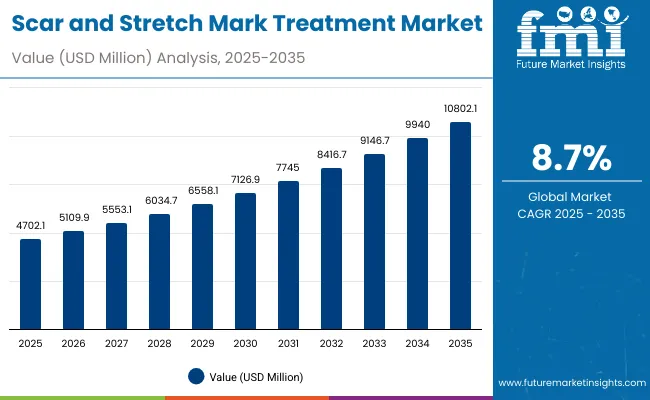
Scar and Stretch Mark Treatment Market Key Takeaways
| Metric | Value |
|---|---|
| Scar And Stretch Mark Treatment Market Estimated Value in (2025E) | USD 4,702.1 million |
| Scar And Stretch Mark Treatment Market Forecast Value in (2035F) | USD 10,802.1 million |
| Forecast CAGR (2025 to 2035) | 8.70% |
Growth is expected to more than double over the decade, driven by increasing adoption of dermatology-supported regimens, wider accessibility of topical solutions, and digital engagement across consumer channels.
Between 2025 and 2030, market expansion from USD 4,702.1 Million to USD 7,126.9 Million is projected, representing an incremental gain of USD 2,424.8 Million, which equates to nearly 40% of the total growth expected over the decade. This early phase is anticipated to benefit from heightened consumer awareness, particularly among women in post-pregnancy care, and expanding product penetration across pharmacies and digital platforms. E-commerce channels are likely to accelerate adoption, capturing a 57.0% share in 2025 and setting the stage for strong online-led momentum.
The second half of the forecast period, from 2030 to 2035, is estimated to contribute USD 3,675.2 Million, accounting for the majority of cumulative growth. During this period, market size is expected to climb from USD 7,126.9 Million to USD 10,802.1 Million, reflecting stronger participation from emerging economies such as India and China, where CAGR levels exceed the global average. Stretch-mark fading applications are anticipated to remain dominant with a 54.0% share in 2025, underpinned by rising adolescent and postpartum demand patterns, while scar reduction and repair-focused regimens will continue to build relevance through dermatologist endorsements and clinically validated claims.
From 2020 to 2024, steady growth in the scar and stretch mark treatment space was recorded, supported by growing awareness of dermatology-guided regimens. By 2025, demand is projected to reach USD 4,702.1 Million, with value expected to more than double by 2035. Market performance is anticipated to be anchored by stretch-mark fading applications and digital-led distribution, as e-commerce captures 57.0% of share in 2025. Competitive activity is projected to intensify, with incumbents defending their positions through dermatologist-tested claims and clinical validation, while emerging players are expected to leverage digital engagement, bundled regimens, and localized postpartum care solutions. Recurring revenue opportunities through subscriptions, replenishment cycles, and personalized digital consultations are forecast to redefine growth dynamics. Advantage is expected to shift toward those capable of blending scientific credibility with consumer-centric digital ecosystems, enabling a sustained leadership position in an increasingly competitive landscape.
Growth in the scar and stretch mark treatment market is being fueled by rising consumer awareness of aesthetic well-being and increasing acceptance of dermatology-guided regimens. Demand is being reinforced by postpartum care routines, adolescent stretch-mark concerns, and the need for visible skin repair solutions. Expansion of e-commerce platforms is enabling easier access, while dermatologist-tested and clinically validated claims are strengthening consumer trust. Emerging economies such as India and China are contributing significantly as higher birth rates, growing disposable incomes, and digital engagement platforms are accelerating adoption. Technological advances in formulations, including natural and pregnancy-safe variants, are also widening appeal. Pharmaceutical and mass retail channels are expected to remain relevant, though digital-first distribution is forecast to dominate due to convenience and subscription-based replenishment models. Overall, long-term growth is being shaped by lifestyle-driven demand, clinical credibility, and expanding regional penetration, ensuring a sustained trajectory for the decade ahead.
The scar and stretch mark treatment market is structured across multiple dimensions that capture consumer demand patterns and clinical positioning. Segmentation by treatment type includes topical creams and serums, oils and butters, silicone gels, and clinical procedure support, reflecting the diversity of product formats available to address varying skin concerns. Functional segmentation covers stretch mark fading, scar reduction, hydration, and elasticity improvement, emphasizing both targeted interventions and broader skin health benefits. Distribution channels are divided among pharmacies and drugstores, e-commerce platforms, dermatology clinics, and mass retail, highlighting the transition toward digital-first ecosystems while preserving traditional points of trust. Claims segmentation features dermatologist-tested, fragrance-free, natural/organic, and pregnancy-safe categories, which reinforce safety and credibility as decisive purchase drivers. End-user segmentation spans women post-pregnancy, adolescents experiencing growth-related stretch marks, and men seeking skin-care solutions, ensuring that adoption is analyzed across diverse demographics. Regionally, coverage extends across North America, Europe, Asia-Pacific, Latin America, and the Middle East & Africa, with emerging economies such as China and India positioned to drive accelerated growth. This layered segmentation provides clarity on both current market dynamics and future opportunities for expansion.
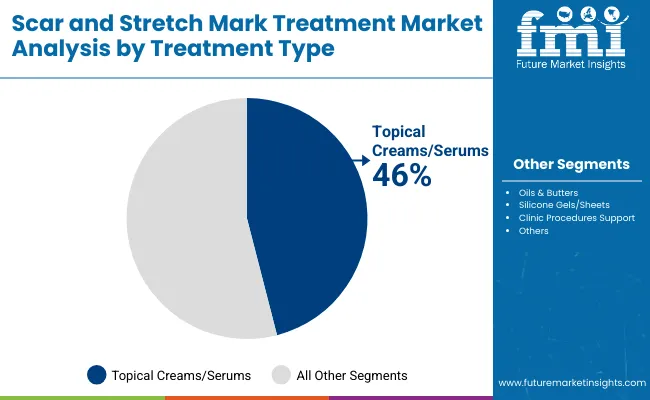
| Treatment Type | Market Value Share, 2025 |
|---|---|
| Topical creams/serums | 46% |
| Others | 54.0% |
The treatment type segment is projected to be led by the category defined as others, with a share of 54.0% in 2025, equivalent to USD 2539.13 Million. This dominance is expected to be supported by broader consumer acceptance of multi-formulation regimens that go beyond traditional topical creams. Greater demand for diversified treatment solutions, including oils, butters, and alternative formats, is anticipated to support continued expansion. Topical creams and serums, accounting for 46% share in 2025, will remain relevant due to their ease of use and widespread distribution, but long-term growth is expected to be more fragmented across innovative categories. The treatment landscape is forecast to evolve as clinical claims and lifestyle preferences increasingly dictate adoption patterns.
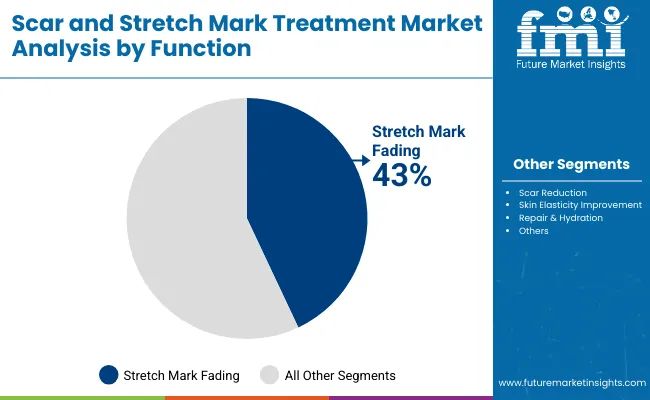
| Function | Market Value Share, 2025 |
|---|---|
| Stretch mark fading | 43% |
| Others | 57.0% |
In the function-based segmentation, the others category is expected to account for 57.0% of total market value in 2025, reaching USD 2680.20 Million. Broader positioning across skin repair, hydration, and elasticity improvements is anticipated to fuel this outcome, aligning with demand for comprehensive skincare benefits. Stretch mark fading is projected to contribute 43% share, valued at USD 2021.90 Million, reflecting consistent demand from postpartum women and adolescents. However, increasing preference for multi-purpose formulations addressing overall skin health is projected to strengthen the dominance of the broader function category. Continued clinical validation and evolving claims are expected to enhance consumer trust and expand adoption within this segment.
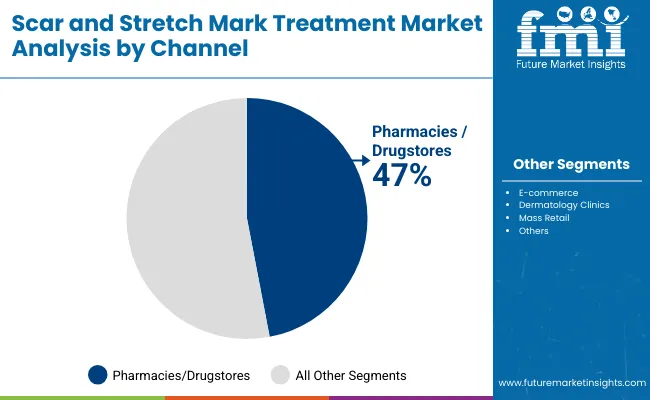
| Channel | Market Value Share, 2025 |
|---|---|
| Pharmacies/drugstores | 47% |
| Others | 53.0% |
The channel segment is forecast to be dominated by others, representing 53.0% of market share in 2025 with a sales value of USD 2492.11 Million. This dominance reflects the rapid rise of e-commerce platforms, dermatology clinics, and mass retail formats that are expanding consumer access. Pharmacies and drugstores, holding 47% share valued at USD 2209.99 Million, will continue to play an important role by providing professional guidance and trusted access points for first-time buyers. However, convenience-driven digital adoption, coupled with subscription and replenishment models, is projected to sustain the leadership of alternative channels. The distribution structure is expected to shift further toward digitally enabled ecosystems, amplifying the relevance of oMillionichannel strategies in driving long-term growth.
The market is being shaped by evolving consumer expectations and clinical influences, even as competitive pressures and distributional realignments add complexity to long-term growth pathways across regions and demographic groups.
Clinical Validation and Dermatologist Endorsements
Market expansion is being accelerated through stronger reliance on evidence-based positioning. Products supported by dermatologist-tested claims and clinical trial validation are expected to secure higher adoption, as consumers increasingly seek proof of efficacy before committing to long-term regimens. This shift reflects a broader trend where trust is being derived not solely from brand heritage but from measurable outcomes and transparent clinical data. The competitive edge is projected to tilt toward companies that can combine safety assurances with credible timelines for visible results. With pregnancy-safe and adolescent-friendly formulations gaining traction, endorsement by healthcare practitioners is anticipated to serve as a critical bridge between consumer curiosity and purchase commitment, reinforcing market legitimacy and scaling adoption across geographies.
Saturation of Traditional Distribution Channels
Growth is being limited by reliance on conventional pharmacy and retail networks that are becoming increasingly crowded with overlapping offerings. While these outlets provide accessibility, differentiation is being diluted, and consumer loyalty is fragmenting across a multitude of similar claims. Pricing pressures are also intensifying, with established players competing against digital-first entrants offering bundled regimens at competitive rates. This structural saturation is forecast to slow incremental growth in physical retail, forcing stakeholders to reallocate investments toward digital ecosystems where consumer decision-making is influenced by reviews, influencer credibility, and subscription-driven retention models. Unless distributional innovation is prioritized, incumbents risk eroding margins while failing to capture emerging demand channels.
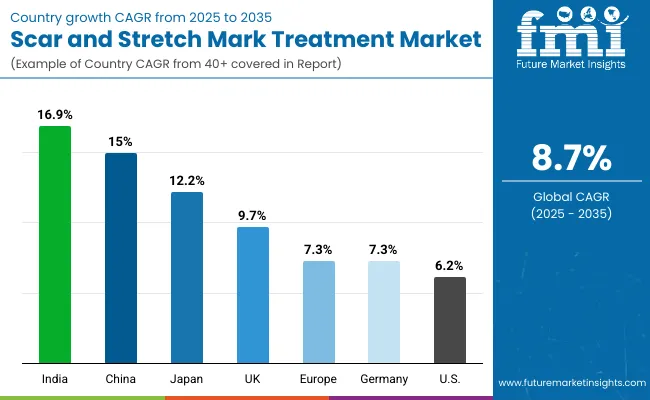
| Country | CAGR |
|---|---|
| China | 15.0% |
| USA | 6.2% |
| India | 16.9% |
| UK | 9.7% |
| Germany | 7.3% |
| Japan | 12.2% |
The global scar and stretch mark treatment market reveals distinct growth patterns across major economies, shaped by demographic drivers, cultural influences, and access to dermatology-led solutions. India is expected to post the strongest trajectory with a CAGR of 16.9% between 2025 and 2035, underpinned by high birth rates, rapid urbanization, and expanding digital penetration that brings postpartum and adolescent skincare routines into mainstream adoption. China follows with a projected CAGR of 15.0%, driven by rising disposable incomes, increased awareness of dermatology-endorsed regimens, and the rapid shift to e-commerce channels that amplify product reach.
Japan, with an estimated CAGR of 12.2%, is expected to maintain steady expansion through premium positioning, as demand for clinically validated and anti-aging-oriented solutions gains traction among health-conscious consumers. The UK and Germany show moderate growth at 9.7% and 7.3% respectively, where mature retail networks and regulatory scrutiny shape brand differentiation, particularly for dermatologist-tested and natural formulations. The USA market, at a projected CAGR of 6.2%, reflects slower expansion due to market maturity, though innovation in claims, oMillionichannel integration, and bundled regimen solutions is expected to sustain relevance. Collectively, Asia-Pacific is positioned as the fastest-growing region, reinforcing its role as the principal engine of long-term market expansion.
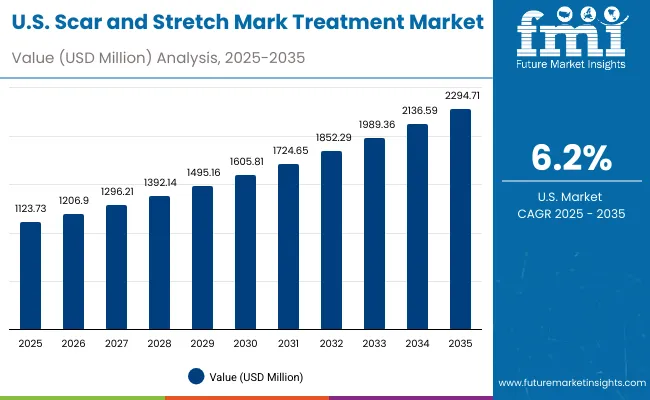
| Year | USA Scar And Stretch Mark Treatment Market (USD Million) |
|---|---|
| 2025 | 1123.73 |
| 2026 | 1206.90 |
| 2027 | 1296.21 |
| 2028 | 1392.14 |
| 2029 | 1495.16 |
| 2030 | 1605.81 |
| 2031 | 1724.65 |
| 2032 | 1852.29 |
| 2033 | 1989.36 |
| 2034 | 2136.59 |
| 2035 | 2294.71 |
The scar and stretch mark treatment market in the United States is projected to grow at a CAGR of 7.0% between 2025 and 2035, reaching USD 2294.71 Million by the end of the period from USD 1123.73 Million in 2025. This progression reflects consistent year-on-year gains, supported by increasing prioritization of aesthetic dermatology and expanding accessibility through retail and digital platforms. Adoption is anticipated to be driven by postpartum care solutions, adolescent skincare demand, and growing reliance on clinically validated, dermatologist-tested claims. The role of oMillionichannel distribution is projected to intensify, with pharmacies maintaining credibility for first-time purchases and e-commerce building momentum through subscriptions and personalized product bundles.
The scar and stretch mark treatment market in the United Kingdom is projected to grow at a CAGR of 9.7% between 2025 and 2035, reflecting solid momentum supported by clinical credibility and consumer-driven adoption. The market is expected to benefit from heightened awareness of postpartum care and increasing preference for dermatologist-tested solutions. Regulatory scrutiny over product claims is anticipated to shape market positioning, making transparency in efficacy and safety pivotal to consumer trust. Pharmacies are projected to remain strong distribution channels, while e-commerce expansion is expected to capture digitally engaged younger demographics.
The scar and stretch mark treatment market in India is projected to expand at a CAGR of 16.9% between 2025 and 2035, making it the fastest-growing among key global markets. This trajectory is expected to be powered by high birth rates, increasing urbanization, and expanding digital access across metropolitan and semi-urban regions. Adoption is likely to be enhanced by growing awareness of postpartum regimens, alongside rising interest in natural and pregnancy-safe formulations. Market expansion is projected to be supported by e-commerce penetration, which is rapidly bridging gaps in product availability and consumer education.
The scar and stretch mark treatment market in China is projected to advance at a CAGR of 15.0% between 2025 and 2035, driven by demographic scale, rising incomes, and rapid digital integration. E-commerce ecosystems are expected to dominate adoption, with subscription and bundled regimen models gaining traction among digitally engaged consumers. Postpartum and adolescent skincare routines are likely to be normalized within mainstream beauty and wellness practices, further enhancing market penetration. International brands and local challengers are anticipated to compete aggressively through claim-based differentiation, while premium positioning with dermatologist validation is expected to resonate with aspirational buyers.
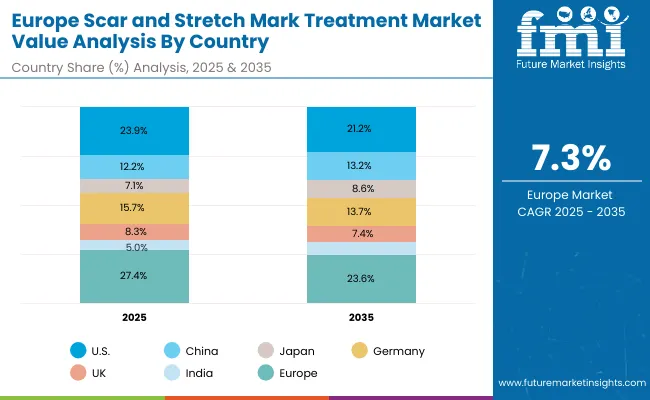
| Country | 2025 |
|---|---|
| USA | 23.9% |
| China | 12.2% |
| Japan | 7.1% |
| Germany | 15.7% |
| UK | 8.3% |
| India | 5.0% |
| Country | 2035 |
|---|---|
| USA | 21.2% |
| China | 13.2% |
| Japan | 8.6% |
| Germany | 13.7% |
| UK | 7.4% |
| India | 6.1% |
The scar and stretch mark treatment market in Germany is forecast to grow at a CAGR of 7.3% between 2025 and 2035, reflecting steady but moderate expansion in a mature European environment. Demand is expected to be anchored by clinical rigor, regulatory oversight, and consumer preference for dermatologist-recommended formulations. Pharmacies are anticipated to remain dominant as trust channels, while e-commerce expansion provides incremental access for digitally engaged consumers. Growth is projected to be slower compared to emerging economies, though premium positioning and sustainable formulations are expected to secure strong traction among health-conscious buyers.
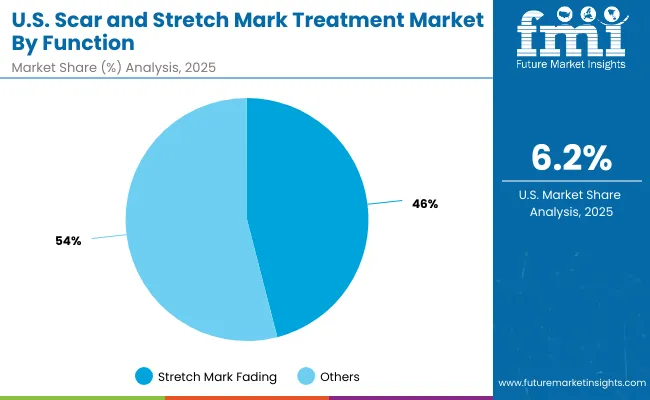
| Segment | Market Value Share, 2025 |
|---|---|
| Stretch mark fading | 46% |
| Others | 54.0% |
The scar and stretch mark treatment market in the United States is projected at USD 1123.73 Million in 2025. Stretch mark fading contributes 46%, equivalent to USD 516.92 Million, while other functions collectively account for 54.0%, valued at USD 606.82 Million. The marginal dominance of broader functions highlights a market orientation toward comprehensive skin improvement regimens rather than narrowly targeted outcomes. This balance reflects evolving consumer expectations for multi-functional benefits such as hydration, elasticity repair, and overall skin health. Rising demand for pregnancy-safe and dermatologist-tested solutions is expected to enhance adoption across both categories. Over the next decade, differentiation is anticipated to rely on clinical validation, subscription-based replenishment models, and oMillionichannel engagement that increases regimen adherence.
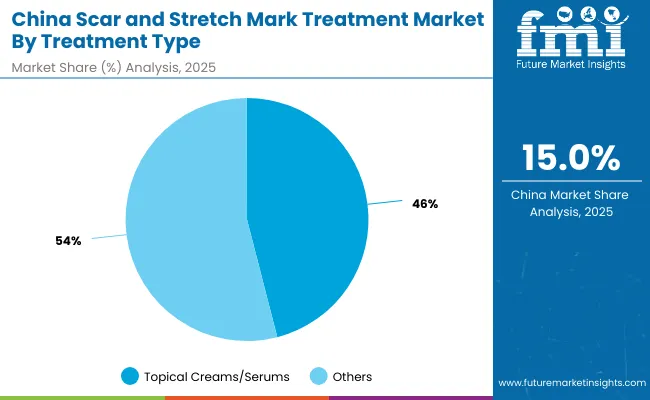
| Segment | Market Value Share, 2025 |
|---|---|
| Topical creams/serums | 46% |
| Others | 54.0% |
The scar and stretch mark treatment market in China is projected at USD 574.35 Million in 2025. Within this, topical creams and serums contribute 46%, valued at USD 264.20 Million, while other treatment types collectively dominate with 54.0%, equivalent to USD 310.15 Million. This distribution indicates a growing consumer preference for diversified formats such as oils, butters, and advanced dermatology-led alternatives beyond conventional topicals. Demand is expected to be reinforced by increasing postpartum care awareness, adolescent stretch-mark management, and broader adoption of multi-functional skincare regimens. Expanding e-commerce ecosystems in China are forecast to amplify accessibility, while premium product positioning backed by clinical claims is likely to enhance trust and accelerate uptake.
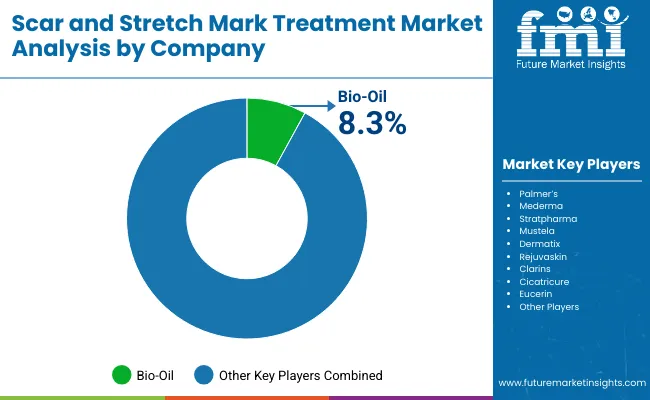
| Company | Global Value Share 2025 |
|---|---|
| Bio-Oil | 8.3% |
| Others | 91.7% |
The scar and stretch mark treatment market is moderately fragmented, with global leaders, regional specialists, and emerging digital-first players competing across diverse consumer groups. Bio-Oil remains the dominant player globally, holding an estimated 8.3% value share in 2025, making it the largest single brand in the category. Its leadership is supported by strong brand equity, dermatologist endorsements, and consistent presence across both pharmacy and e-commerce channels.
Mid-sized competitors such as Palmer’s, Mederma, and Mustela are expected to play significant roles through differentiated positioning, including natural formulations, pregnancy-safe claims, and targeted regimens for adolescent or postpartum users. Dermatix, Rejuvaskin, Clarins, Cicatricure, and Eucerin contribute further to competitive intensity, each building traction in regional markets through claim-specific product lines and trusted dermatology associations.
Specialist providers are increasingly leveraging digital commerce, influencer-driven marketing, and subscription bundles to scale rapidly, even without dominant global shares. Competitive advantage is shifting away from single-product formats toward multi-functional regimens that combine hydration, elasticity repair, and scar reduction in a single solution.
Competitive differentiation is anticipated to rely heavily on clinical validation, localized marketing strategies, and oMillionichannel integration. While Bio-Oil is projected to maintain leadership, growth from challengers is expected to accelerate through digital-first strategies and bundled offerings.
Key Developments in Scar and Stretch Mark Treatment Market
| Item | Value |
|---|---|
| Quantitative Units | USD 4,702.1 Million (2025) - USD 10,802.1 Million (2035) |
| Treatment Type | Topical creams/serums, Oils & butters, Silicone gels/sheets, Clinical procedure support |
| Function | Stretch mark fading, Scar reduction, Skin elasticity improvement, Repair & hydration |
| Channel | Pharmacies/drugstores, E-commerce, Dermatology clinics, Mass retail |
| Claim | Dermatologist-tested, Fragrance-free, Natural/organic, Pregnancy-safe |
| End User | Women (post-pregnancy), Men, Adolescents (growth stretch marks) |
| Regions Covered | North America, Europe, Asia-Pacific, Latin America, Middle East & Africa |
| Countries Covered | United States, China, India, United Kingdom, Germany, Japan |
| Key Companies Profiled | Bio-Oil, Palmer’s, Mederma, Stratpharma, Mustela, Dermatix, Rejuvaskin, Clarins, Cicatricure, Eucerin |
| Additional Attributes | Dollar sales by treatment type, channel, and claims; adoption trends in postpartum care and adolescent skincare; shift toward e-commerce and subscription models; clinical validation and dermatologist endorsements; premium positioning in Japan and Europe; high growth in India and China; fragmentation with Bio-Oil leading global share (8.3%). |
The global Scar and Stretch Mark Treatment Market is estimated to be valued at USD 4,702.1 million in 2025.
The market size for the Scar and Stretch Mark Treatment Market is projected to reach USD 10,802.1 million by 2035.
The Scar and Stretch Mark Treatment Market is expected to grow at a CAGR of 8.7% between 2025 and 2035.
The key product types in the Scar and Stretch Mark Treatment Market include topical creams/serums, oils & butters, silicone gels/sheets, and clinical procedure support.
In terms of function, stretch mark fading is expected to command a 46% share in the Scar and Stretch Mark Treatment Market in 2025.






Our Research Products

The "Full Research Suite" delivers actionable market intel, deep dives on markets or technologies, so clients act faster, cut risk, and unlock growth.

The Leaderboard benchmarks and ranks top vendors, classifying them as Established Leaders, Leading Challengers, or Disruptors & Challengers.

Locates where complements amplify value and substitutes erode it, forecasting net impact by horizon

We deliver granular, decision-grade intel: market sizing, 5-year forecasts, pricing, adoption, usage, revenue, and operational KPIs—plus competitor tracking, regulation, and value chains—across 60 countries broadly.

Spot the shifts before they hit your P&L. We track inflection points, adoption curves, pricing moves, and ecosystem plays to show where demand is heading, why it is changing, and what to do next across high-growth markets and disruptive tech

Real-time reads of user behavior. We track shifting priorities, perceptions of today’s and next-gen services, and provider experience, then pace how fast tech moves from trial to adoption, blending buyer, consumer, and channel inputs with social signals (#WhySwitch, #UX).

Partner with our analyst team to build a custom report designed around your business priorities. From analysing market trends to assessing competitors or crafting bespoke datasets, we tailor insights to your needs.
Supplier Intelligence
Discovery & Profiling
Capacity & Footprint
Performance & Risk
Compliance & Governance
Commercial Readiness
Who Supplies Whom
Scorecards & Shortlists
Playbooks & Docs
Category Intelligence
Definition & Scope
Demand & Use Cases
Cost Drivers
Market Structure
Supply Chain Map
Trade & Policy
Operating Norms
Deliverables
Buyer Intelligence
Account Basics
Spend & Scope
Procurement Model
Vendor Requirements
Terms & Policies
Entry Strategy
Pain Points & Triggers
Outputs
Pricing Analysis
Benchmarks
Trends
Should-Cost
Indexation
Landed Cost
Commercial Terms
Deliverables
Brand Analysis
Positioning & Value Prop
Share & Presence
Customer Evidence
Go-to-Market
Digital & Reputation
Compliance & Trust
KPIs & Gaps
Outputs
Full Research Suite comprises of:
Market outlook & trends analysis
Interviews & case studies
Strategic recommendations
Vendor profiles & capabilities analysis
5-year forecasts
8 regions and 60+ country-level data splits
Market segment data splits
12 months of continuous data updates
DELIVERED AS:
PDF EXCEL ONLINE
Scar Treatment Market Overview - Growth & Demand Forecast 2025 to 2035
Stretch Marks Treatment Market Size and Share Forecast Outlook 2025 to 2035
Acne Scarring Treatments Market Analysis - Size and Share Forecast Outlook 2025 to 2035
Stretch Mark Prevention Creams Market Size and Share Forecast Outlook 2025 to 2035
Stretch Mark Removal Products Market Insights - Growth & Forecast 2025 to 2035
Market Positioning & Share in the Stretch Film Industry
Stretch Films Market Outlook - Size, Demand & Industry Trends 2025 to 2035
Treatment Pumps Market Insights Growth & Demand Forecast 2025 to 2035
Stretch Wrapper Market Growth - Demand & Forecast 2025 to 2035
Scarfing Inserts Market Analysis - Size, Share, and Forecast Outlook 2025 to 2035
Anti-Stretch Marks Agents Market Size and Share Forecast Outlook 2025 to 2035
Stretch Hood Films Market Analysis by Up to 50 microns, 50-100 microns, 100-150 microns, 150 microns & above Through 2035
Stretch Film Packs Market Insights on Type, Product, Application, Industry, and Region - 2025 to 2035
Boxcar Scars Market – Demand, Growth & Forecast 2025 to 2035
Stretch Sleeve Label Market Insights – Growth & Demand 2024-2034
Water Treatment Market Size and Share Forecast Outlook 2025 to 2035
Stretcher Accessories Market Size and Share Forecast Outlook 2025 to 2035
Mascara Applicators Market Size and Share Forecast Outlook 2025 to 2035
UVI Stretch Films Market Size and Share Forecast Outlook 2025 to 2035
Burns Treatment Market Overview – Growth, Demand & Forecast 2025 to 2035

Thank you!
You will receive an email from our Business Development Manager. Please be sure to check your SPAM/JUNK folder too.
Chat With
MaRIA